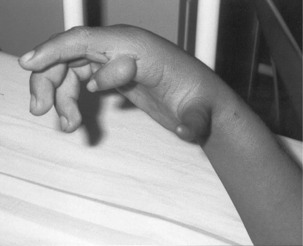Circuit C
STATION 1
This station assesses your ability to elicit clinical signs:
STATION 2
This station assesses your ability to elicit clinical signs:
STATION 3
This station assesses your ability to elicit clinical signs:
STATION 4
This station assesses your ability to elicit clinical signs:
STATION 5
This station assesses your ability to elicit clinical signs:
CLINICAL SCENARIO
On general inspection the child is pale and looks small for his age. He is playing with a toy in his mother’s arms and you notice an abnormality to his right hand. On closer inspection he appears to have two thumbs but both are hypoplastic. The more proximal lacks a distal phalangeal segment and the distal is attached by only a small piece of skin (see Fig. 3).
What more do you want to examine in his upper limbs?
After presenting your findings, which other parts of the body will you examine?
STATION 6
This station assesses your ability to assess specifically requested areas in a child with a developmental problem:
STATION 7
This station assesses your ability to communicate appropriate, factually correct information in an effective way within the emotional context of the clinical setting:
STATION 8
This station assesses your ability to communicate appropriate, factually correct information in an effective way within the emotional context of the clinical setting:
STATION 9
This station assesses your ability to take a focused history and explain to the parent your diagnosis or differential management plan:
COMMENTS ON STATION 1
DIAGNOSIS: AORTIC STENOSIS
It would be nice if every child seen in the cardiovascular station has obvious signs and symptoms – but they don’t. You may have a child with an unusual congenital heart defect whose abnormality is impossible to determine on clinical examination. So it is important to know what to rule out if your child has a murmur of indeterminate origin.
Did you remember to ask the examiner to check peripheral pulses and perform a blood pressure?
REMINDERS
Turner’s syndrome (full details can be found on p. 184) 5X (although mosaicism possible)
Cardiac disorders are the cause of increased mortality in this syndrome
Aortic coarctation most common cardiac defect
Dental malocclusion increased, so prophylaxis vital
Predisposition to keloid scar formation (child may have cardiac surgical scars)
Indication for using growth hormone (and consider using steroid to increase final height).
| Aortic stenosis | Tips |
|---|---|
| Exam | Apex beat (do you always examine this?) may be displaced |
| Suprasternal and carotid thrill | |
| Systolic murmur in aortic region and left sternal edge | |
| Have you felt for peripheral pulses? (Associated with coarctation) | |
| The slow rising pulse is a very difficult sign to elicit | |
| Have you listened to the back? (Not always helpful but there shouldn’t be radiation, unlike in coarctation) | |
| A budding cardiology professor may pick up the diastolic murmur of aortic incompetence, which is more likely to occur post-surgery | |
| Investigation | ECG normal in the well child but may show signs of left ventricular hypertrophy:Stay updated, free articles. Join our Telegram channel
Full access? Get Clinical Tree
 Get Clinical Tree app for offline access
Get Clinical Tree app for offline access

|
